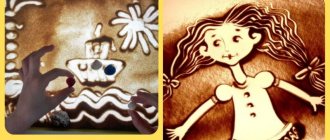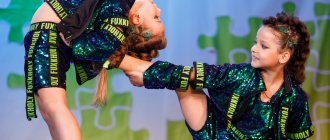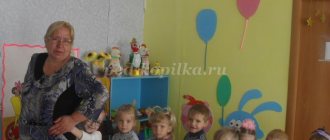Methods and techniques of teaching. Design training in the first and second junior groups of kindergarten
Contents of classes
Learning Objectives
Design training in the first and second junior groups of kindergarten
First junior group.
Children are introduced to building materials - cubes, bricks, shape, size, different locations on the table plane (a brick is lying, standing) and different stability depending on the position, they are taught to place bricks horizontally (train, path), to lay one on top of the other, to combine various placements, forming simple ceilings (gates, houses) or enclosing space (fences). The teacher teaches children to find similarities between buildings and familiar objects in life around them.
Second junior group.
Children are taught not only to distinguish the main building parts (cube, brick, plate), but also to name them, as well as understand and use words such as big, small, long, short, high, low,
they are taught to place bricks at equal distances from each other in a circle, along a quadrangle (fence, fence), placing them on a narrow plane, they begin to teach purposeful examination of objects and buildings.
First junior group.
Children are taught to build 8-10 simple buildings: furniture (table, chair, sofa, bed), tower, ladder, slide, bridge, house, tram. At the first lessons, the buildings that the kids made in the previous group are repeated, then the children build furniture.
At first, children create each item separately and in different versions; after mastering, they offer to make two or three buildings at once (table and chairs, table and sofa, etc.). To play with these buildings, children are given dolls, dishes, and scraps (dolls rest, dolls eat, etc.).
In the next lesson, children build a tower with a bird house from 3-4 cubes placed on top of each other, and cover them on top with a triangular prism; Then they build a ladder of 6 cubes or bricks, practicing placing the parts up. Familiar techniques are reinforced in the construction of the slide.
The next stage of work (when the children master these buildings, learn to reproduce according to the teacher’s words, and play) is the construction of a bridge from two cubes, a plate and two small triangular prisms. The ability to enclose a space and make ceilings is reinforced by the construction of a garage and a tram.
In the kindergarten area and in the group room, the teacher encourages children to reproduce the buildings they created in class and plays with them.
Second junior group.
The first 3-4 lessons in the second junior group (if the children have moved from the first junior group) are devoted to strengthening the ability to place bricks in a row on a plane, making a path or line. Children build a short narrow path to the house, a wide path for cars.
Next, you can propose to build a tram line: the short lines made by each child are combined into a single long one. The main goal of these classes is to teach children to carefully connect bricks, lining them up, and to distinguish spatial features: short - long, narrow - wide.
Over the next two or three lessons, children learn to place the bricks vertically - either tightly together or at an equal distance from each other; bricks can be placed on a narrow long plane or on a narrow short plane. For this purpose, children are taught to build a fence for animals (the teacher draws attention to the fact that first they build a fence, then place a duck, a dog), a fence near the house, etc.
In subsequent lessons, children master various gate options (made of bricks, cubes, plates), learn to arrange parts vertically, and carry out construction in a certain sequence. Views are narrow
-
wide, low
-
high
are specified by constructing gates: wide for a truck and narrow for a car, high for a large matryoshka doll and low for a small one.
After mastering the method (changing the same building - a gate - by replacing some parts with others), children are introduced to another method of changing a building - adding a superstructure in height and length. Over the course of several lessons, children are given a new construction in a strict system. Moreover, each time it is necessary to compare the new design with the previous one and establish the differences and similarities between them.
Note:
To check whether children have learned to reproduce a given house design based on a model, they need to be given the task of independently transforming this model: for example, build the same house (i.e., keep the structure itself), but only tall or long, etc. Having previously explained the principle of lengthening or increasing the height of a building using the first design. Setting this kind of task (transforming a sample) helps to increase the mental activity of children.
For training in the first and second junior groups, sets of cubes, bricks, plates and triangular prisms from Kaluga building material by M. P. Agapova are used, as well as building sets No. 3 and No. 4, developed by the Toy Research Institute.
At the beginning of the year, in the first junior group during classes, the teacher makes subgroups of 4-6 children. Gradually the number of groups increases, and from the second half of the year classes are held with the entire group.
A variety of methods are used to teach design to children of younger groups. But the main place is occupied by information-receptive and reproductive methods, i.e. children are introduced to what and how to build, i.e. they are shown a model, explained in detail, and shown the process of constructing a building.
Before starting training, it is necessary to acquaint children with the depicted object itself, both as a whole and with parts, explaining their actual purpose.
Purposeful examination of objects allows children to successfully reproduce them in their own buildings. For example, during a walk on a hill, it is necessary to draw children's attention to the ladder along which children climb the hill, and to the ramp located on the other side along which they slide down.
At the beginning of each lesson, the sample is reviewed as a whole. Preschoolers tend to perceive individual parts, rather than the entire object as a whole, which makes it difficult to reproduce the object. By identifying individual parts of the structure together with the children, the shape of these parts and their spatial arrangement in relation to each other are determined. This examination order corresponds to the sequence of construction of the building and thereby makes it easier for children to construct it.
Constructive activities become more interesting if poems, songs, fairy tales and fairy-tale characters are used in working with children.
At the end of each lesson, they show the children how to play with this building and provide this opportunity (2-3 minutes), which creates interest in the play activity.
Comment:
Toys initially distract children from the constructive process itself, but it is the toy that encourages a young child to build, because they cannot take into account dimensions when designing, and the toy must correspond to the dimensions of the parts.
Comment:
In order for children to learn the names of constructive material, they need to pay attention to it not only during classes, but also in the process of cleaning up after classes and games (the building is dismantled, the parts are grouped on the table: cubes, bricks, plates, etc., and then removed from the table ).
During the construction process, the teacher makes sure that the children follow the model exactly, select the materials correctly and use them correctly, helps some (without interfering with others) with advice, a question (“Will your car get through the gate?”), sometimes practical action. If the teacher sees that many children cannot complete the task, or noticing common mistakes, he uses repeated explanation, while focusing on the points that cause difficulty
Analyzing children's activities, the teacher notes not only its results (correctness and accuracy of construction), but also the process itself: how the children looked at the sample, selected materials, performed individual actions, etc.
After classes with building materials, the teacher systematically shows the children how buildings are dismantled and the material is put back in place.
GCD "construction for 1st junior group"House for a bunny"
GCD "Construction" in 1st junior group
"House for the Bunny"
Target:
Continue to develop the ability to construct elementary buildings according to the teacher’s demonstration and word, and use building materials to independently construct simple buildings in the game.
Tasks:
Cognitive:
1. Consolidate knowledge about the names of construction set parts: cube, brick, prism (roof).
2. Strengthen the ability to place parts on a plane, promote understanding of spatial relationships.
3. Activate children’s active and passive vocabulary using words: cube, brick, roof, house, bench, table, chair, sofa, guests, bunny.
Educational:
1.Develop memory, attention, observation.
2. Continue to teach children how to build elementary buildings according to a model, and show a desire to build something on their own.
3. Continue to strengthen the ability to use additional story toys, commensurate with the scale of buildings to play out the story.
4.Continue to teach children to put the construction set in a box after finishing the game.
Educational:
1.Promote care for animals; evoke positive emotions.
2. Continue to teach children to listen carefully to the teacher and follow verbal instructions.
Equipment:
1.Toy: hare.
2. For each child: a construction set (parts needed for construction: 10 cubes, 2 prisms, 5 bricks), 3-4 small toys to play out the plot.
GCD move:
1.Organization of children: The teacher organizes the children to form a circle and reads the nursery rhyme:
A steam locomotive goes and goes, two pipes and a hundred wheels,
Two pipes, a hundred wheels, a red dog as a driver.
Tra-ta-ta, tra-ta-ta, take your seats!
Children move like a train in a circle, then sit at the tables.
2. A surprise moment: a bunny comes to visit and tells him that the fox, whose house melted, kicked him out of the house and now he has nowhere to live.
3. The teacher invites the children to teach the bunny to build a house:
- clarifies with children what parts are on their table (cubes, bricks, roof);
-shows the technique of building a house from 8 cubes and a prism.
4. Children build a house based on the teacher’s model and verbal instructions.
5. Physical exercise.
Girls and boys jump like bunnies.
Hands clap, feet stomp,
They nod their heads, crouch low,
And then everyone gets up, waves their hands: “Salute”!
6. The teacher says that guests may come to the bunny and offers to build a bench, table, and chairs for them near the house. Reminds us of what parts they can be built from (a bench from bricks, a table from a cube and a brick, a chair seat from a cube, a back from a brick). Children build buildings.
Summary of lessons on designing Teremok nursery
Abstract of GCD for the design of “Teremok”
Target
: developing children’s ability to create simple buildings in joint activities.
Tasks
educational activities:
continue to teach children to create a building from ready-made geometric shapes (bricks, cubes, roofs), analyze the object, see the main parts and details that make up the structure;
teach how to build a house according to conditions and models;
exercise the ability to distinguish and name geometric shapes: cube, roof, brick;
expand and enrich children’s vocabulary, strengthen dialogic speech skills;
develop design skills, spatial thinking;
cultivate independence;
develop coordination of hand movements, attention, thinking;
learn to differentiate the concepts of “big and small”;
cultivate a love for animals, develop cognitive interest;
create a joyful mood, an emotional mood.
Integration of educational areas:
“Cognition”, “Communication”, “Socialization”, “Work”, “Music”, “Reading fiction”.
Preliminary work:
reading Teremok fiction, looking at illustrations, constructing outside classes in subgroups and individually, looking at photographs of houses of different sizes, designs and purposes, consultations for parents.
Equipment:
wooden floor construction set, Lego construction set, plastic construction set, soft modules, diagrams, counting sticks.
Activating the dictionary:
brick, cube, door, walls, roof, window.
Progress of educational activities:
Surprise moment:
There is a knock on the door, a bear from the Russian folk tale “Teremok” comes in and cries.
Pedagogical technologies used:
• gaming
• information and communication
• personality-oriented
• health-saving
Artistic and aesthetic development:
• strengthen children’s ability to construct buildings according to a model and support the desire to build something on their own
• consolidate children’s knowledge of the names of construction kit parts
Speech development:
• develop dialogical speech
• cultivate interest in communicating with adults and peers
• activate nouns in the children’s dictionary (teremok, builder, little mouse, frog-frog, runaway bunny, top-gray barrel, little fox-sister, clumsy bear, verbs (lounged, galloped, roared, squeaked)
Cognitive development:
• maintain children's interest and active actions with objects and geometric bodies
• develop attention, thinking, sensory perception
Social and communicative development:
• cultivate friendly relationships during joint activities
Construction in an early age group
| Spring. Transformations, revitalization, awakening of nature. | |||||||||||||||
| 17 | 14.05 | Spring | Sand construction | Reinforce knowledge about the properties of sand. Learn to build a tower, a dog house, paths, benches, tables, etc. Develop thinking, memory, and creativity. Cultivate an interest in sand construction. | Sandbox | Cognitive development (formation of a holistic picture of the world, expansion of horizons, development of research activities, femp), speech development, hair (literary art), skr (s\r\i), physical | I.A.Lykova Design in kindergarten p.18 | ||||||||
| 18 | 28.05 | Flowers | Fences high and low | Teach: change the building in height; name the details: bricks, cubes; build a variety of fences, different in height. Strengthen the ability to arrange parts. Develop a sense of shape and color, an interest in flowers. To cultivate the ability to see the beauty of nature, understand its fragility, and evoke a desire to protect it. | Construction sets, decorative flowers on stands | Cognitive development (formation of a holistic picture of the world, broadening one’s horizons, development of cognitive and research activities, femp), hair (literary arts), physical development | I.A.Lykova Construction in kindergarten p.17 | ||||||||
Pedagogical monitoring is carried out in order to determine the dynamics of the child’s current individual development profile and is used to solve the following problems: • individualization of education (including supporting the child, building his educational trajectory or professional correction of his developmental characteristics); • optimization of work with a group of children. Pedagogical monitoring is based on the principles of supporting the specificity and diversity of childhood, as well as the uniqueness and intrinsic value of childhood as an important stage in the overall development of a person. In this regard, pedagogical monitoring: - does not contain any assessments of the child’s development related to recording educational achievements; — allows you to record the current individual development profile of a preschooler and evaluate its dynamics; — takes into account the child’s zone of proximal development in each direction; — allows us to consider the entire period of a child’s development from birth to school as a single process without conditional division into different age stages “tied” to the passport age, while taking into account age-related patterns of development, based on an assessment of changes in the activity of a preschooler; — takes into account the targets presented in the Program, but does not use them as the basis for their formal comparison with the actual achievements of children. Tools for pedagogical monitoring of child development - observation cards and an electronic application that will allow teachers to analyze the dynamics of child development. Where calculations are carried out using a certain formula. The results obtained are expressed as percentages and determine the so-called success rate of each child. At the beginning of the school year, based on the results of monitoring, the zone of educational needs of each student is determined: a high level corresponds to a zone of increased educational needs, a medium level corresponds to a zone of basic educational needs, and a low and low level corresponds to a risk zone. Accordingly, planning of the educational process is carried out based on the integration of educational areas, taking into account individualization. At the end of the school year, conclusions are drawn about the degree to which the educational needs of children are met and about the achievement of positive dynamics in the educational needs themselves. Principles of assessment - three-level monitoring system - 2 points “quality manifests itself sustainably”, 1 point “quality manifests itself unsustainably”, i.e. is in the zone of proximal development and is manifested only in joint activities with an adult, 0 point - “quality is not manifested.” In some cases (if necessary), psychological diagnostics of children can be carried out. It is carried out by qualified specialists (for example, educational psychologists) and only with the consent of the parents (legal representatives) of the children. The information obtained during monitoring is the basis for predicting activity, making the necessary correction, and a tool for notifying parents about the condition and problems identified in the child. Diagnostic card: Type of activity: Construction




